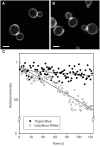Cell wall staining with Trypan blue enables quantitative analysis of morphological changes in yeast cells
- PMID: 25717323
- PMCID: PMC4324143
- DOI: 10.3389/fmicb.2015.00107
Cell wall staining with Trypan blue enables quantitative analysis of morphological changes in yeast cells
Abstract
Yeast cells are protected by a cell wall that plays an important role in the exchange of substances with the environment. The cell wall structure is dynamic and can adapt to different physiological states or environmental conditions. For the investigation of morphological changes, selective staining with fluorescent dyes is a valuable tool. Furthermore, cell wall staining is used to facilitate sub-cellular localization experiments with fluorescently-labeled proteins and the detection of yeast cells in non-fungal host tissues. Here, we report staining of Saccharomyces cerevisiae cell wall with Trypan Blue, which emits strong red fluorescence upon binding to chitin and yeast glucan; thereby, it facilitates cell wall analysis by confocal and super-resolution microscopy. The staining pattern of Trypan Blue was similar to that of the widely used UV-excitable, blue fluorescent cell wall stain Calcofluor White. Trypan Blue staining facilitated quantification of cell size and cell wall volume when utilizing the optical sectioning capacity of a confocal microscope. This enabled the quantification of morphological changes during growth under anaerobic conditions and in the presence of chemicals, demonstrating the potential of this approach for morphological investigations or screening assays.
Keywords: 3D structured illumination; Anaerobiosis; Calcofluor white; Saccharomyces cerevisiae; Trypan blue; cell volume; cell wall staining; super-resolution microscopy.
Figures






References
-
- Andrews P. D., Stark M. J. (2000). Type 1 protein phosphatase is required for maintenance of cell wall integrity, morphogenesis and cell cycle progression in Saccharomyces cerevisiae. J. Cell Sci. 113, 507–520. - PubMed
LinkOut - more resources
Full Text Sources
Other Literature Sources
Molecular Biology Databases

